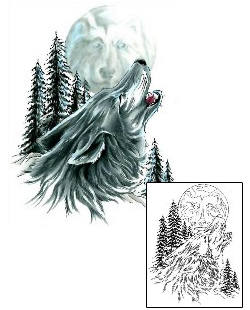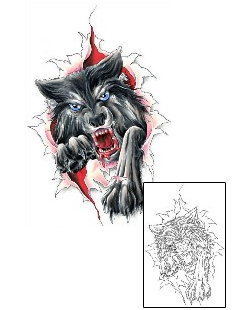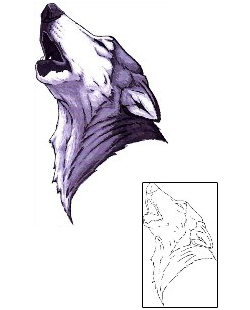The wolf (also known as the grey wolf, the gray wolf or the timber wolf) is the largest wild member of the Canidae family and an ice age survivor that originated around 300,000 years ago. Some DNA studies have found that the wolf may be an ancestor of the domestic dog. The wolf is very adaptable and can thrive in areas as diverse from the mountains to deserts to the urban areas. However, due to the loss of its natural habitats, the wolf's numbers are dwindling. Today, wolves are protected animals in some areas, but hunted for sport or extermination in others.
Wolves figure prominently in folklore. Many Chinese proverbs use the term "wolf" to describe any malicious person with a hidden agenda. "Wolf hearted" is used to describe someone who is so bad, they are impossible to tame. "Wolf heart; dog lungs" refers to an ungrateful person who later betrays someone who previously helped them. TheChristian Bible contains 13 references to wolves, usually as metaphors for greed and destructiveness. Jesus uses wolves to describe the dangers his followers would face should they follow him. The phrase "Wolf in sheep's clothing" refers to someone who seems benign but is really a danger.
In the medieval Russian folktale Ivan Tsarevich and the Grey Wolf, the grey wolf is a benevolent character who uses his knowledge and magical powers to assist Ivan on his quest. In Japan, grain farmers once worshiped wolves at shrines, leaving food near their dens in hopes that they would protect their crops from wild boar and deer. Talismans and charms with wolf images were used to protect against fire, disease and other dangers. The Roman God of War, Mars held the wolf sacred and to spot one before a battle was an omen of victory.
Wolves also play a large part in some Native American tribes. In the Cardinal directions of the Plains Indians, the wolf represented the west, while for the Pawnee, it represented the southeast. According to the Pawnee creation myth, the wolf was the first creature to experience death. The Wolf Star (Sirius), enraged at not having been invited to attend a council on how the Earth should be made, sent a wolf to steal the whirlwind bag of The Storm that Comes out of the West, which contained the first humans. Upon being freed from the bag, the humans killed the wolf, thus bringing death into the world. The Pawnee, being both an agricultural and hunting people, associated the wolf with both corn and the bison; the "birth" and "death" of the Wolf Star was to them a reflection of the wolf's coming and going down the path of the Milky Way known as Wolf Road. Wolves however were not always portrayed positively in Native American cultures. The Netsilik Inuit and Takanaluk-arnaluk believed that the sea-woman Nuliayuk's home was guarded by wolves. The Naskapi's believed that the caribou afterlife is guarded by giant wolves, which kill careless hunters venturing too near. The Navajo people feared witches in wolf's clothing called "Mai-cob".
Wolf tattoos can symbolize many things, depending on the culture and intent of the tattoo wearer. Just as Christ was the Good Shepherd, the wolf can represent Satan. It can also represent ferocity, cunning, stealth, and cruelty. The pack nature of the wolf give it an association with loyalty, courage, fidelity and victory. Wolves are also associated with shape-shifting, fear of the night or darkness, as well as the shadow world. Wolf elements are often found in Native American themed tattoos.
In Native American legend and history, people have been befriended throughout time by something known as a totem spirit. While often the spirit of an animal guardian, this wasn't necessarily the case all of the time. Different men and women bore different totem spirits, some more coveted than others. But perhaps one of the most powerful and astounding totem spirits that could choose to serve as your guardian was the wolf. This belief in totem spirits, while perhaps referred to by other names, has permeated many other religions and walks of life, and the wolf has retained its power and significance among them too. One way that modern people pay tribute to their spirit totem, the Wolf, is by choosing to wear wolf tattoo designs.
But you don't have to believe in totem spirits to wear a wolf tattoo design. Conservationists and nature lovers are a few other people who might proudly bear the wolf emblem. Groups will often use the wolf as part of the symbols because wolves live in packs and communities with a clearly defined social order. Just think of the term, "Alpha Male."
The Popularity of the Wolf Tattoo Design
There are a multitude of reasons that the wolf tattoo design has become so popular in modern culture. But, for the most part, the modern movement towards near reverence of the wolf has been most influenced by Native American awareness and ecological preservation. Something about the primal beauty and glowing wisdom of a wolf in the wild has attracted human attention for as long as the two species have coincided.
The wolf is closely associated with the moon and the lunar cycle, and therefore has come to represent intuition and psychic ability.
If the wolf is recurrently coming to the forefront of your mind, it may be because the wolf spirit is trying to share a life lesson with you. It may be trying to teach you that all things in life have their order, even amongst seemingly chaotic times, and that you should accept your duty with both humility and strength.
Wolves in Myth and Legend
When it comes to the character of the wolf in myth and legend, there is a sharp geographical divide when it comes to interpretation. In European history, the wolf has been feared and reviled, hunted ruthlessly and portrayed as a cruel and cunning villain in many fairy tales and legends. However, when you shift over to the pre-Columbian American cultures, wolves are respected, revered and protected.
While there is no single reason as to why there is this general separation of opinion, many feel that it has something to do with the closeness of the humans and the animals. Europeans, who have largely lived in city type villages and communities, were far less likely to have actually witnessed a wolf in its natural environment. Instead, they and their livestock fell victim to animals who were simply struggling to maintain their normal lives as people first began to encroach upon their territory. However, in the Americas, the native tribes and peoples often lived in very close proximity with wolves, sharing not only their hunting grounds, but their very prey. The Native Americans quickly learned to share their land with the wolf, and began to try to mirror their better qualities.
In Europe, and countries that were European in ancestry or cultural influence, the wolf was the scheming bad guy of tales like "Little Red Riding Hood", "The Wolf and the 7 Kids", "The 3 Little Pigs." But, although the European tales warn of the wolf's ferocity, they also testify to its cunning and preternatural intelligence. While generally reviled throughout European myth and legend, even they have given the wolf a kind of grudging respect in their testimonies of fear.
Further east, where the towns and villages are smaller and the imaginations much larger, the wolf myths took on their most sinister form yet, in the form of the werewolves. Here, the bestial intelligence of the wolf was evilly married to the functional, social and mental capacities of a human who was bound by a curse to change into its animal form on the dawn of the full moon. Werewolves still heavily populate our horror movies and thrillers.
Farther away, in the early Americas, the wolf still carried with him his dignity, honor and status. To some point, these amazing creatures really had "adopted" the Native Americans, and stood guard over them in a nearly domesticated bond of fierce loyalty and protection. But it must be understood that wolves and "dogs" were worlds and worlds apart, and it was not deemed appropriate to mix their breeds. The wolf has a soul in the Nunamuite Eskimo's eyes: not so their sled dogs. The wolf is an integral part of many religious ceremonies; the dog would be rather unceremoniously kicked out of any ceremonial lodge.
According to Native American legend, the wolf had great powers given to him by the Great Spirit. It was even said that a wolf could change into a man in order to help a man that was in trouble. The Sioux word for wolf is Skunkmanitu Tonka, which in the English tongue would be rendered "the animal that looks like a dog but has a powerful spirit." This is a far cry from the ideas of the European werewolf.
Choosing a Wolf Tattoo Design
Does the eerie strain of the wolf howling at the moon send delightful shivers down your spine? Is he lurking through your house in pictures, figurines and decor? Has he crept into your dreams and waking thoughts?
Then remember everything you can about your "own" wolf. Is it a lone wolf, or a member of a pack? Is he howling, or is he hunting? Is your wolf a pup or an alpha male? Is he a star wolf, like the Dog Star Sirius?
Does your wolf hide from you in the shadows, is it a shadow wolf? Do you never see his eyes, but only his footprints? Is your wolf nursing her pups in the safety of their den?
Wolves come in many varieties and colors. There are grey wolves, white wolves, timber wolves, black wolves, red wolves and arctic wolves. They can be captured in the stark, angular designs of tribal tattoos and armbands; or they can be carefully interwoven and knotted in the Celtic form.
Pair your wolf with the moon, or a mountain. Add in a buffalo or deer. Capture the spirit of the wolf in your design, and learn to design your life to make yourself worthy of the call and mark of the wolf.










